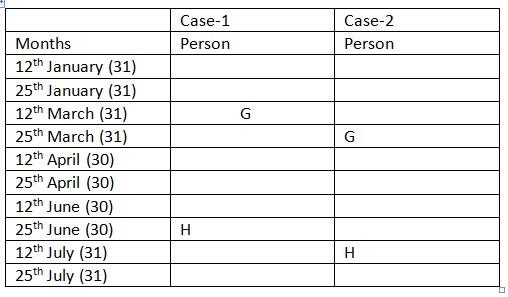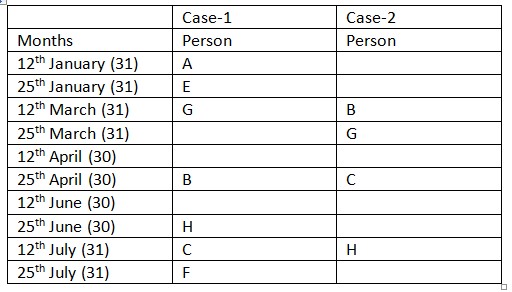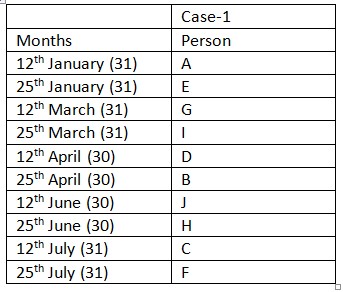Question
Who among the following are the persons who goes for
seminar on the first and the last day? Study the following information carefully and answer the given questions: There are ten persons namely A, B, C, D, E, F, G, H, I and J. They go for seminars on 12th and 25th of different months i.e., January, March, April, June and July but not necessarily in the same order. G goes for seminar in the month which have odd number of days but not in January. Four persons goes for seminar between G and H. E did not go for seminar on an even date. G goes for seminar before H. I goes for seminar in the month which has odd numbers of days. D goes for seminar on an even date of the month which has even number of days after E. A goes for seminar just before E. Only two persons goes for seminar between I and J. F goes for seminar just after C but not in April and January. Only three persons goes for seminar between B and F. E and F goes for seminar on the same date but different months.Solution
G goes for seminar in the month which have odd number of days but not in January. Four persons goes for seminar between G and H. G goes for seminar before H. We will have two cases: If G goes for seminar on 12th March, then H will goes for seminar on 25th June. If G goes for seminar on 25th March, then H will goes for seminar on 12th July.  A goes for seminar just before E. E did not go for a seminar on an even date. F goes for seminar just after C but not in April and January. Only three persons goes for seminar between B and F. E and F goes for seminar on the same date but different months. If F goes for seminar on 25 th July, then B will goes for seminar on 25 th April and C will goes for seminar on 12 th July. E will goes for seminar on 25 th January. If F goes for seminar on 12th June, then B will goes for seminar on 12th March and C will goes for seminar on 25th April but this case will get discarded as we cannot place E.
A goes for seminar just before E. E did not go for a seminar on an even date. F goes for seminar just after C but not in April and January. Only three persons goes for seminar between B and F. E and F goes for seminar on the same date but different months. If F goes for seminar on 25 th July, then B will goes for seminar on 25 th April and C will goes for seminar on 12 th July. E will goes for seminar on 25 th January. If F goes for seminar on 12th June, then B will goes for seminar on 12th March and C will goes for seminar on 25th April but this case will get discarded as we cannot place E.  I goes for seminar in the month which has odd numbers of days. D goes for seminar on an even date of the month which has even number of days after E. Only two persons goes for seminar between I and J. I goes for seminar on 25th March. J goes for seminar on 12th June. D goes for seminar on 12th April.
I goes for seminar in the month which has odd numbers of days. D goes for seminar on an even date of the month which has even number of days after E. Only two persons goes for seminar between I and J. I goes for seminar on 25th March. J goes for seminar on 12th June. D goes for seminar on 12th April. 
Who has been reappointed for a second term as the Executive Director of UN Women in 2025?
When was the Botanical Survey of India (BSI) founded?
What was SBI’s net profit in FY25?
India’s first ambulance for street animals has been launched in ______________ which is started by the Blue Cross of India in collaboration with ...
In March 2022, Katalin Novak was elected as the first-ever female _____________ of Hungary.
Which of the following are correctly matched with respect to Drama and their Author?
Who is the CMD of REC Ltd.?
Who has been appointed as the chief selector of the Indian men's cricket team?
Why is the National Crisis Management Committee (NCMC) meeting, and what is the current status of the impending cyclonic storm 'Michaung'?
Consider the following statements in regards to generative AI.
1) It is a transformative type of artificial intelligence.
2) Accenture has...
Relevant for Exams:


